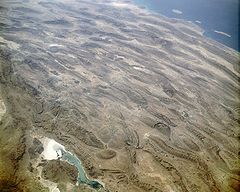
Fold mountain
Encyclopedia

Mountain
Image:Himalaya_annotated.jpg|thumb|right|The Himalayan mountain range with Mount Everestrect 58 14 160 49 Chomo Lonzorect 200 28 335 52 Makalurect 378 24 566 45 Mount Everestrect 188 581 920 656 Tibetan Plateaurect 250 406 340 427 Rong River...
s formed mainly by the effects of folding
Fold (geology)
The term fold is used in geology when one or a stack of originally flat and planar surfaces, such as sedimentary strata, are bent or curved as a result of permanent deformation. Synsedimentary folds are those due to slumping of sedimentary material before it is lithified. Folds in rocks vary in...
on layers within the upper part of the Earth's crust. In the time before either plate tectonic theory developed, or the internal architecture of thrust belts became well understood, the term was used for most mountain belts, such as the Himalayas
Himalayas
The Himalaya Range or Himalaya Mountains Sanskrit: Devanagari: हिमालय, literally "abode of snow"), usually called the Himalayas or Himalaya for short, is a mountain range in Asia, separating the Indian subcontinent from the Tibetan Plateau...
. The term is still fairly common in physical geography
Physical geography
Physical geography is one of the two major subfields of geography. Physical geography is that branch of natural science which deals with the study of processes and patterns in the natural environment like the atmosphere, biosphere and geosphere, as opposed to the cultural or built environment, the...
literature but has otherwise generally fallen out of use except as described below. The forces responsible for formation of the fold mountains are called orogenic movements. The term orogenic has derived from a Greek word meaning mountain building. These forces act at tangent to the surface of the earth and are primarily a result of plate tectonics.
Formation
Fold mountains are formed when two tectonic plates move together (a convergent plate boundary). Fold mountains are usually formed from sedimentary rocks which accumulated along the margins of continents. When plates and the continents riding on them collide, the accumulated layers of rock may crumple and fold like a tablecloth that is pushed across a table, particularly if there a mechanically weak basal layer such as saltHalite
Halite , commonly known as rock salt, is the mineral form of sodium chloride . Halite forms isometric crystals. The mineral is typically colorless or white, but may also be light blue, dark blue, purple, pink, red, orange, yellow or gray depending on the amount and type of impurities...
.
Examples
- The Jura mountainsJura mountainsThe Jura Mountains are a small mountain range located north of the Alps, separating the Rhine and Rhone rivers and forming part of the watershed of each...
- A series of sub-parallel mountainous ridges formed by folding over a TriassicTriassicThe Triassic is a geologic period and system that extends from about 250 to 200 Mya . As the first period of the Mesozoic Era, the Triassic follows the Permian and is followed by the Jurassic. Both the start and end of the Triassic are marked by major extinction events...
evaporiteEvaporiteEvaporite is a name for a water-soluble mineral sediment that result from concentration and crystallization by evaporation from an aqueous solution. There are two types of evaporate deposits, marine which can also be described as ocean deposits, and non-marine which are found in standing bodies of...
decollement due to thrust movements in the forelandForelandForeland is the easternmost point of the Isle of Wight. It is located three miles east of the town of Brading, and due south of the city of Portsmouth on the British mainland. It is characterised by a pub called the Crab and Lobster and various beach huts plus a beach cafe and a coast guard...
of the AlpsAlpsThe Alps is one of the great mountain range systems of Europe, stretching from Austria and Slovenia in the east through Italy, Switzerland, Liechtenstein and Germany to France in the west....
. - The Zagros mountains - A series of elongated anticlinal domes, mostly formed as fault bend folds over underlying thrusts in the foreland of the Zagros collisional beltZagros fold and thrust beltThe Zagros fold and thrust belt is a ~1800 km long zone of deformed crustal rocks, formed in the foreland of the collision between the Arabian Plate and the Eurasian Plate...
generally above a basal decollement formed in the NeoproterozoicNeoproterozoicThe Neoproterozoic Era is the unit of geologic time from 1,000 to 542.0 ± 1.0 million years ago. The terminal Era of the formal Proterozoic Eon , it is further subdivided into the Tonian, Cryogenian, and Ediacaran Periods...
Hormuz evaporite.
See also
- Fault-block mountainFault-block mountainFault-block landforms are formed when large areas of bedrock are widely broken up by faults creating large vertical displacements of continental crust....
- Fold and thrust belt
- OrogenyOrogenyOrogeny refers to forces and events leading to a severe structural deformation of the Earth's crust due to the engagement of tectonic plates. Response to such engagement results in the formation of long tracts of highly deformed rock called orogens or orogenic belts...
- Mountain building

